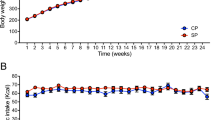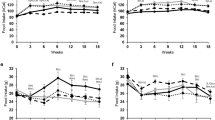Abstract
Objective:
To determine if myostatin deficiency attenuates body fat gain with increased dietary fat intake.
Methods:
Normal and myostatin-deficient mice were fed control (8–10 kcal %fat) and high-fat (HF) (45 kcal %fat) diets for a period of 8 weeks, starting at 2 months of age. Body composition, including percent body fat, lean mass, and fat mass, were measured using DXA. Serum adipokines were measured using a Beadlyte assay.
Results:
Two-factor ANOVA revealed significant treatment × genotype interactions for body fat (g), percent body fat, and serum leptin. The HF diet significantly increased body fat, percent body fat, and serum leptin in normal mice but not in myostatin-deficient mice.
Conclusion:
Loss of myostatin function not only increases muscle mass in animal models but also attenuates the body fat accumulation that usually accompanies an HF diet.
This is a preview of subscription content, access via your institution
Access options
Subscribe to this journal
Receive 12 print issues and online access
$259.00 per year
only $21.58 per issue
Buy this article
- Purchase on Springer Link
- Instant access to full article PDF
Prices may be subject to local taxes which are calculated during checkout
Similar content being viewed by others
References
McPherron AC, Lawler AM, Lee S-J . Regulation of skeletal muscle mass in mice by a new TGF-β superfamily member. Nature 1997; 387: 83–90.
Ji S, Losinski R, Cornelius S, Frank G, Willis G, Gerrard D et al. Myostatin expression in porcine tissues: tissue specificity and developmental and postnatal regulation. Am J Physiol 1998; 275: R1265–R1273.
McPherron AC, Lee S-J . Suppression of body fat accumulation in myostatin-deficient mice. J Clin Invest 2002; 109: 595–601.
Lin J, Arnold H, Della-Fera MA, Azain MJ, Hartzell DL, Baile CA . Myostatin knockout in mice increases myogenesis and decreases adipogenesis. Biochem Biophys Res Comm 2002; 291: 701–706.
Schuelke M, Wagner K, Stolz L, Hubner C, Riebel T, Komen W et al. Myostatin mutation associated with gross muscle hypertrophy in a child. N Engl J Med 2004; 350: 2682–2688.
Milan G, Dalla N, Pilon C, Pagano C, Granzatto M, Manco M et al. Changes in muscle myostatin expression in obese subjects after weight loss. J Clin Endocrinol Metab 2004; 89: 2724–2727.
Kim H, Liang L, Dean R, Hausman D, Hartzell D, Baile CA . Inhibition of preadipocyte differentiation by myostatin treatment in 3T3-L1 cultures. Biochem Biophys Res Comm 2001; 281: 902–906.
Rebbapragada A, Benchabane H, Wrana J, Celeste A, Attisano L . Myostatin signals through a transforming growth factor β-like signaling pathway to block adipogenesis. Mol Cell Biol 2003; 23: 7230–7242.
Artaza J, Bhasin S, Magee T, Reisz-Porszasz S, Shen R, Groome N et al. Myostatin inhibits myogenesis and promotes adipogenesis in C3H 10T(1/2) mesenchymal multi-potent cells. Endocrinology 2005; 146: 3547–3557.
Fiorotto M, Schwartz R, Delaughter M . Persistent IGF-1 overexpression in skeletal muscle transiently enhances DNA accretion and growth. FASEB J 2003; 17: 59–60.
Musaro A, McCullagh K, Paul A, Houghton L, Dobrowolny G, Molinaro M et al. Localized IGF-1 transgene expression sustains hypertrophy and regeneration in senescent skeletal muscle. Nat Genet 2001; 27: 195–200.
Lai K, Gonzalez M, Poueymirou W, Kline W, Na E, Zlotchenko E et al. Conditional activation of akt in adult skeletal muscle induces rapid hypertrophy. Mol Cell Biol 2004; 24: 9295–9304.
Sutrave P, Kelly A, Hughes S . Ski can cause selective growth of skeletal muscle in transgenic mice. Genes Dev 1990; 4: 1462–1472.
Acknowledgements
Funding for this research was supported in part by the Medical College of Georgia and by the National Institutes of Health (NIAMS AR049717-01A2). The Medical College of Georgia IACUC approved the protocol (#05-03-479) used in this study.
Author information
Authors and Affiliations
Corresponding author
Rights and permissions
About this article
Cite this article
Hamrick, M., Pennington, C., Webb, C. et al. Resistance to body fat gain in ‘double-muscled’ mice fed a high-fat diet. Int J Obes 30, 868–870 (2006). https://doi.org/10.1038/sj.ijo.0803200
Received:
Revised:
Accepted:
Published:
Issue Date:
DOI: https://doi.org/10.1038/sj.ijo.0803200
Keywords
This article is cited by
-
Functional replacement of myostatin with GDF-11 in the germline of mice
Skeletal Muscle (2022)
-
Vav2 catalysis-dependent pathways contribute to skeletal muscle growth and metabolic homeostasis
Nature Communications (2020)
-
The histone deacetylase SIRT6 blocks myostatin expression and development of muscle atrophy
Scientific Reports (2017)
-
Inhibition of myostatin in mice improves insulin sensitivity via irisin-mediated cross talk between muscle and adipose tissues
International Journal of Obesity (2016)
-
Investigating mechanisms underpinning the detrimental impact of a high-fat diet in the developing and adult hypermuscular myostatin null mouse
Skeletal Muscle (2015)



